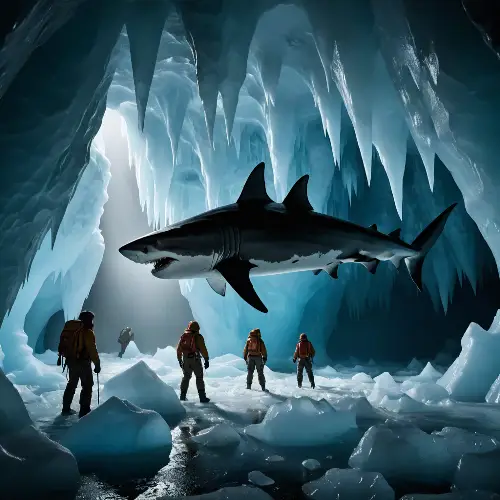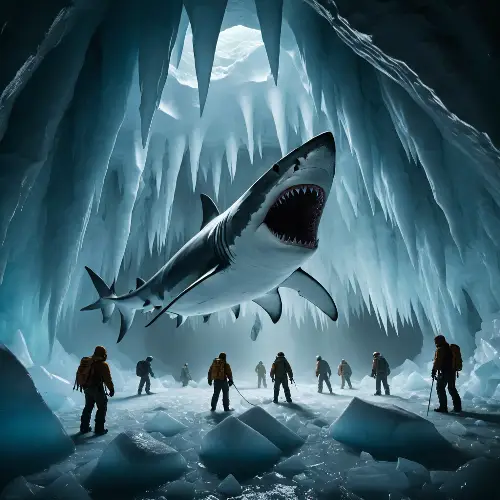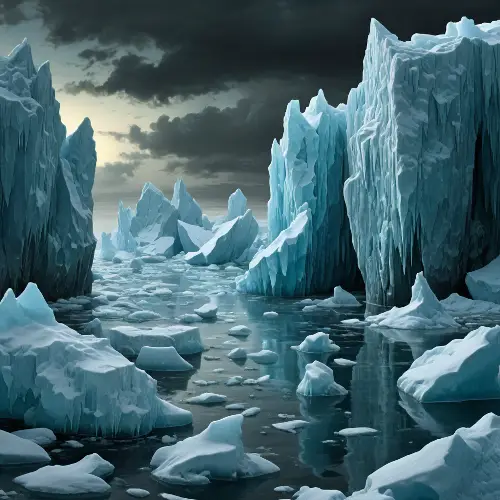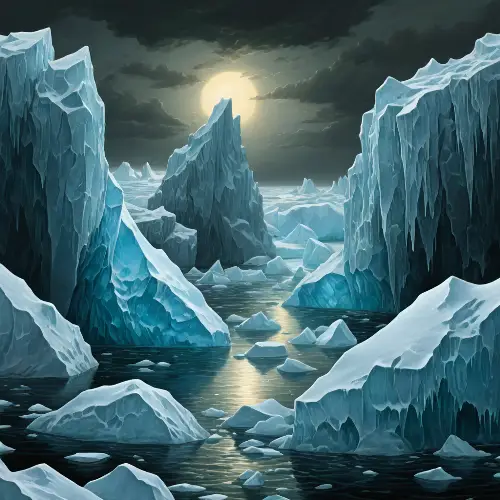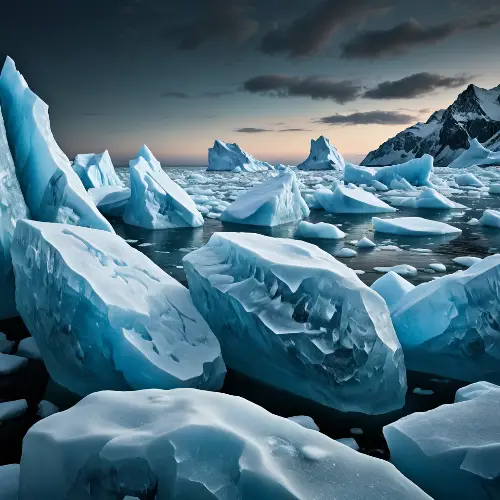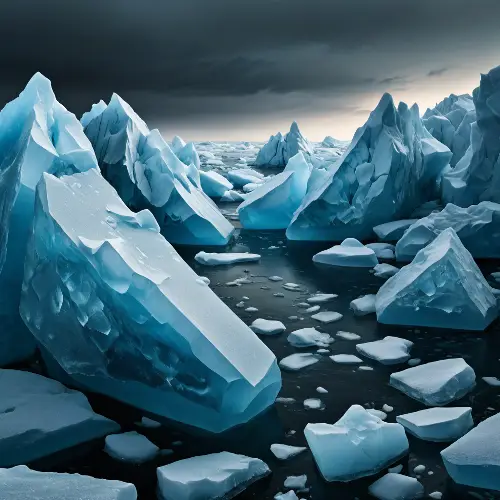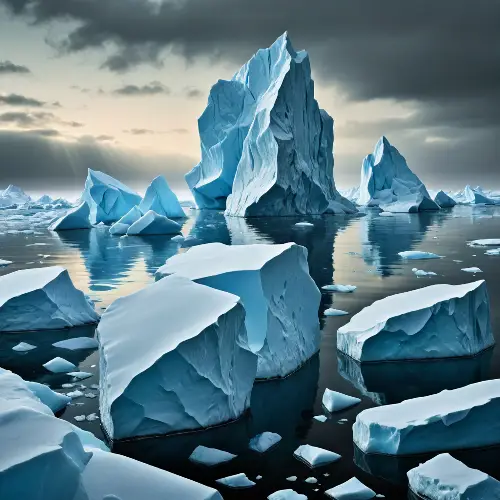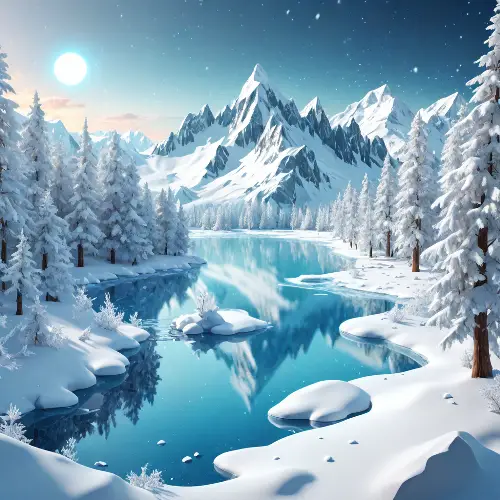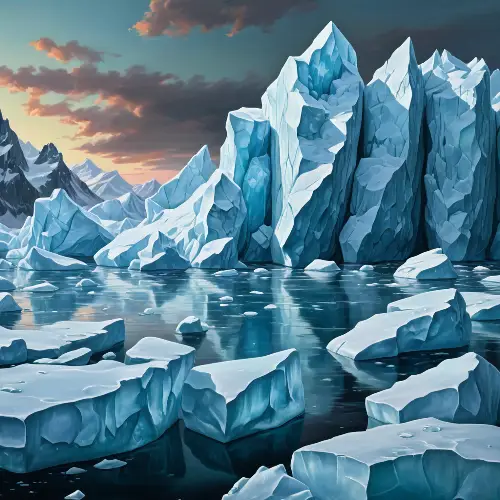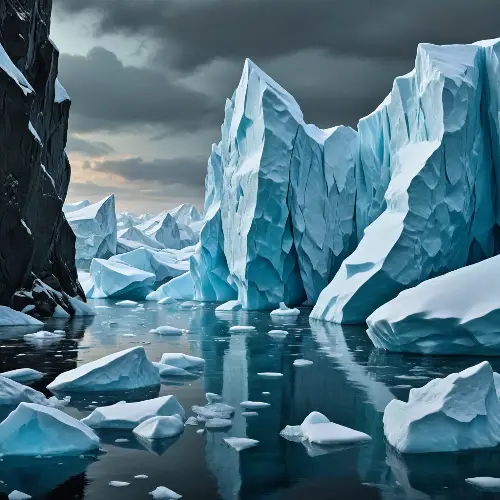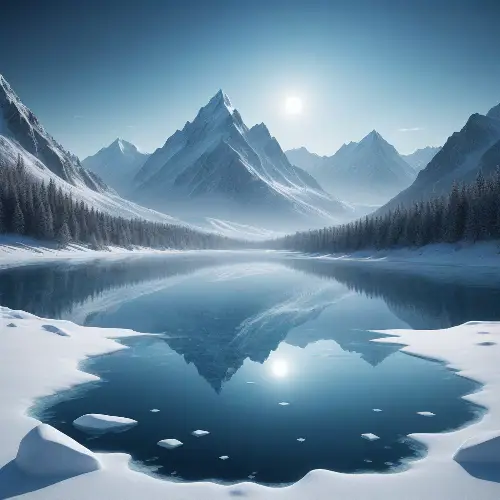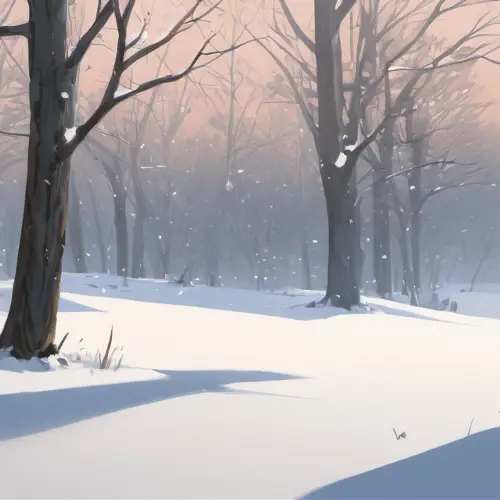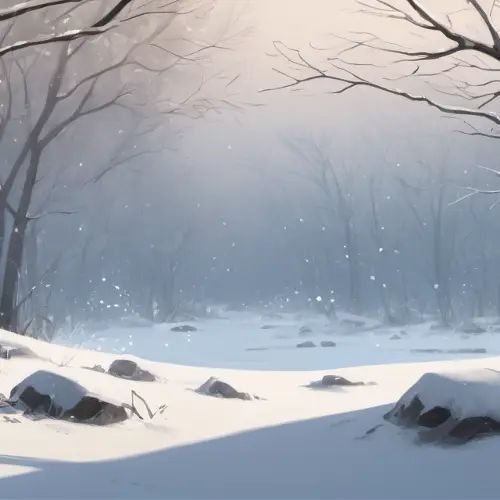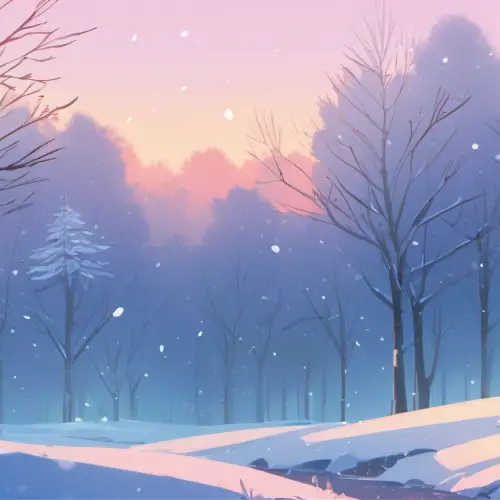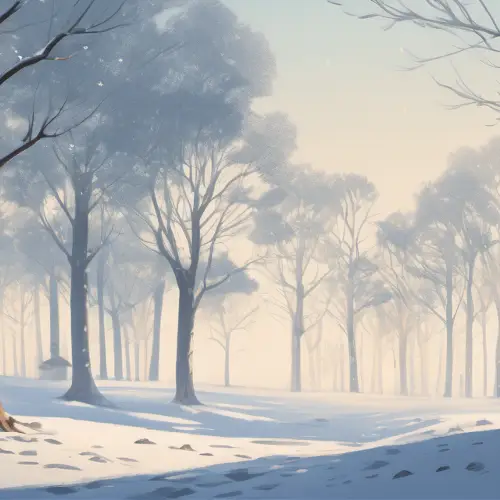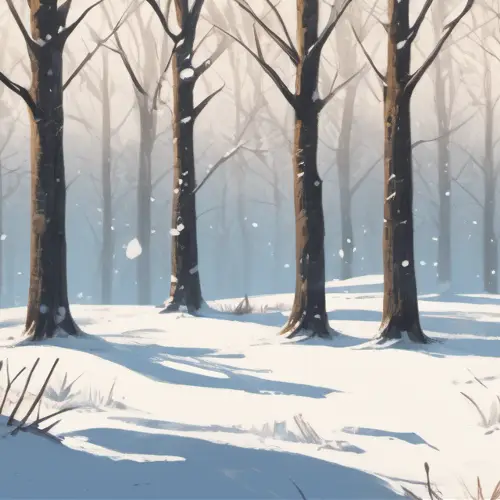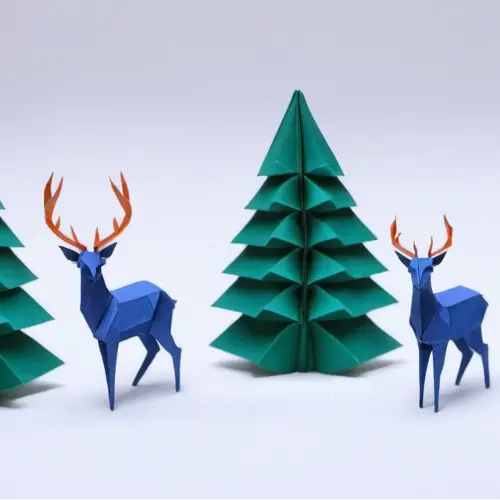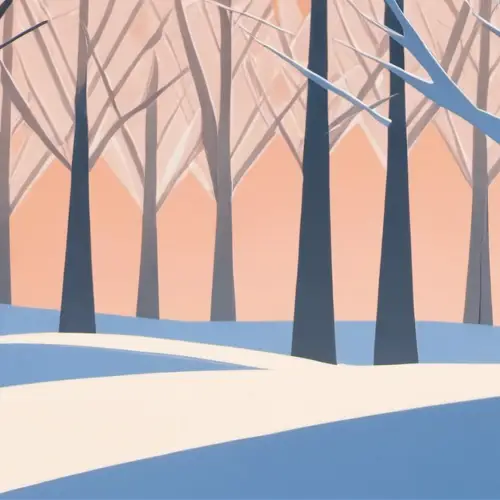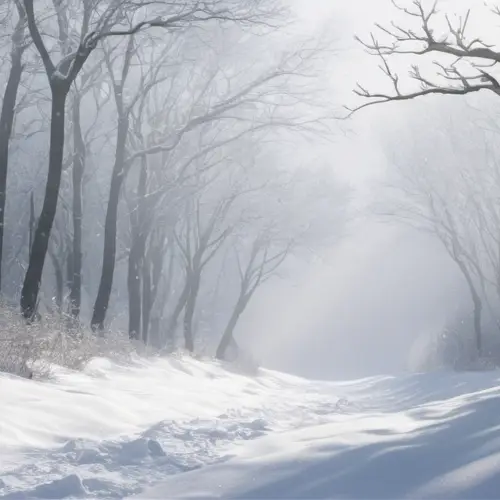Compose a compelling digital illustration showcasing the poignant scene of an animal encased in an iceberg within a frozen wasteland. Picture the detailed features of the frozen creature, capturing both the realism of its form and the icy translucency of the surrounding iceberg. Set the scene against a desolate, frozen landscape, with vast icy expanses stretching to the horizon. Convey a sense of isolation and timelessness, where the frozen environment tells a silent tale of the animals preservation in an arctic sanctuary.
More Like This
Envision an animal completely trapped in a magical encasement of ice, frozen in a lifelike pose. Surround the scene with a vast, frozen wasteland — a desolate landscape of icy tundras and snow-covered terrain. Capture the delicate details of the frozen creature, emphasizing the contrast between the intricate ice formations and the harsh, wintry environment. Ensure the scene radiates an aura of enchantment, conveying the magic and power of the Frostbind spell.
a dramatic and imaginative image depicting a scene with a strong sense of adventure and danger. It features a group of people, clad in cold-weather clothing, exploring a vast ice cavern. At the center of the scene is a gigantic shark, seemingly frozen within a clear block of ice, with its mouth open wide displaying sharp teeth. The shark is positioned as if it's lunging towards a precipice in the ice where some explorers stand, creating a sense of imminent threat. Above the shark, on the left and right sides of the cavern, are more explorers, standing on the edges or traversing narrow ice bridges, holding onto ropes for safety. The lighting in the cavern is ethereal, with a cool blue tone that casts dramatic shadows and emphasizes the textures of the ice. The cavern walls are illuminated softly, suggesting the light may be filtering in from an unseen source above. In the background, more explorers can be seen gathered around a camp with tents, some are standing and appear to be looking towards the shark. A small fire burns, adding a contrasting warm glow to the predominantly cold blue environment. The image evokes a narrative reminiscent of a scene from a fantasy or science fiction story, where explorers have come across a prehistoric creature preserved in ice. It's a scene that is both beautiful and menacing, filled with tension and the potential for storytelling.
a dramatic and imaginative image depicting a scene with a strong sense of adventure and danger. It features a group of people, clad in cold-weather clothing, exploring a vast ice cavern. At the center of the scene is a gigantic shark, seemingly frozen within a clear block of ice, with its mouth open wide displaying sharp teeth. The shark is positioned as if it's lunging towards a precipice in the ice where some explorers stand, creating a sense of imminent threat. Above the shark, on the left and right sides of the cavern, are more explorers, standing on the edges or traversing narrow ice bridges, holding onto ropes for safety. The lighting in the cavern is ethereal, with a cool blue tone that casts dramatic shadows and emphasizes the textures of the ice. The cavern walls are illuminated softly, suggesting the light may be filtering in from an unseen source above. In the background, more explorers can be seen gathered around a camp with tents, some are standing and appear to be looking towards the shark. A small fire burns, adding a contrasting warm glow to the predominantly cold blue environment. The image evokes a narrative reminiscent of a scene from a fantasy or science fiction story, where explorers have come across a prehistoric creature preserved in ice. It's a scene that is both beautiful and menacing, filled with tension and the potential for storytelling.
In this frozen scene, imposing icebergs embody the force of nature. The sea, frozen and still, reveals an inviting coldness in fresh tones. The contrasts between dark crevices and sparkling ice create an atmosphere where the cold is almost welcoming. Inspired by “The Sea of Ice” by Friedrich, the work magnifies grandeur and solitude. Influenced by the illustrations of Gustave Doré, he combines details with a romantic vision of nature. The painting evokes contemplative solitude, amplified by towering icebergs, each crack telling a story of endurance against time, showcasing the power of nature. It transcends a simple landscape, meditating on the grandeur, fragility, and majesty of the frozen world. Witchcraft casts its icy spell over the entire scene, creating a magical, frozen atmosphere that enchants the entire landscape.
a character trapped inside an iceberg, the crystallized and beautiful shine of the iceberg is in centre frame compared to the icy tundra and snow capped mountains in the background.
a character trapped inside an iceberg, the crystallized and beautiful shine of the iceberg is in centre frame compared to the icy tundra and snow capped mountains in the background.
In this glacial landscape, towering icebergs stand majestically, their commanding presence evoking the unwavering force of nature. The frozen sea stretches as far as the eye can see, captured in a still state by the relentless cold that reigns. The carefully selected cool shades of blues and whites reveal a welcomingly cold panorama, where glacial light accentuates the details of the ice crystals, creating a striking visual play. The dramatic contrasts between the darkness of the icy crevasses and the light that sparkles on the tops of the icebergs help to create an atmosphere where the coldness becomes almost hospitable. The artistic use of these cold tones and contrasts emphasizes the immensity of the scene, capturing the viewer's gaze and inviting them to explore the infinite depth of this frozen landscape. This powerful work is directly inspired by “La Mer de Glace” by Caspar David Friedrich. The elements of grandeur and solitude, dear to the German artist, are magnified here. The artistic composition, inspired by the color illustrations of Gustave Doré, skillfully combines precise details with a romantic and symbolic vision of nature. At the heart of this painting, a feeling of contemplative solitude emerges, amplified by the imposing presence of the icebergs. Each crack in the ice tells a story of endurance in the face of time's icy embrace, reinforcing the unchanging power of nature. Thus, this work transcends the simple landscape to become a visual meditation on the grandeur, fragility and majesty of our frozen world.
Illustrate a hand-drawn 3D sketch featuring a network analysis visualization forming the hidden structure beneath an iceberg. Capture the simplicity of a clear and blank surface above, emphasizing the intricate relationships in a sketched, cinematic manner. The side-shot perspective should evoke a sense of hand-crafted intrigue. Create a hand-sketched scene portraying a network analysis integrated into the concealed base of an iceberg. Utilize the charm of hand-drawn lines to symbolize the transparent surface above, leaving room for the viewer's imagination. Infuse cinematic elements in a sketched style to convey the realism and hidden complexity of the submerged network. Craft a visually engaging hand-drawn sketch of a 3D scene, showcasing a network analysis structure as the hidden foundation of an iceberg. Emphasize the simplicity of the clear surface above through hand-drawn details, while using cinematic strokes to bring out the unseen connections. The side view should exude the charm of a hand-drawn illustration.
In this icy scene, towering icebergs symbolize nature's unstoppable force. The frozen sea extends endlessly, captured in stillness by relentless cold. Cool blues and whites create an inviting coldness, with glacial light highlighting ice crystals. Dramatic contrasts between dark icy crevices and sparkling iceberg summits forge an atmosphere where the cold almost feels welcoming. The artistic use of these tones and contrasts captures attention, inviting exploration into the infinite depth of this frozen landscape. Inspired by Caspar David Friedrich's “The Sea of Ice,” this artwork magnifies elements of grandeur and solitude. Influenced by Gustave Doré's illustrations, it skilfully blends precise details with a romantic and symbolic view of nature. At its core, the painting evokes a contemplative solitude, amplified by the imposing icebergs. Each crack in the ice tells a tale of endurance against the icy embrace of time, reinforcing nature's immutable power. Thus, the artwork transcends a simple landscape, becoming a visual meditation on the grandeur, fragility, and majesty of our frozen world. style: fantasy
Create a graphic design that metaphorically portrays a submerged iceberg, with the top part showcasing a clean and minimalist surface, symbolizing transparency. Beneath the surface, intricately weave a network analysis, subtly communicating hidden messages and relationships. The design should balance aesthetics and functionality.
Generate a 3D render of a network analysis visualization forming the submerged, hidden structure of an iceberg. Emphasize the clear and blank surface above, capturing the essence of concealed complexity beneath. Provide a side-shot perspective with cinematic and realistic elements to enhance the visual impact. Craft an immersive 3D rendering showcasing a network analysis representation integrated into the hidden base of an iceberg. The surface above should remain transparent and unmarked, symbolizing the concealed relationships beneath. Use cinematic techniques to add realism and depth, capturing the intrigue of the unseen connections. Design a visually compelling 3D scene featuring a network analysis structure forming the concealed portion of an iceberg. Focus on the clear and blank surface above to convey the concept of hidden complexity. Optimize the rendering for a side view, incorporating cinematic elements to bring realism to the intricate network relationships.
Prompt 1: imagine prompt: Beary, a chubby bear cub, sitting on a sunlit grassy hill, surrounded by vibrant wildflowers, its brown fur gleaming, capturing the pure joy and simplicity of nature, Illustration, colored pencils on textured paper, --ar 9:16 --v 5 Prompt 2: imagine prompt: Bearie exploring a cozy forest filled with oversized mushrooms, the sunlight streaming through the foliage, emphasizing the warmth and comfort of its woodland home, Artwork, digital painting, --ar 16:9 --v 5 Prompt 3: imagine prompt: In a bustling market square, Beary surrounded by colorful stalls and friendly animals, capturing the lively spirit of a bear-friendly community, Sculpture, crafted from clay and fabric, --ar 1:1 --v 5 Prompt 4: imagine prompt: Bearie, adorned with a crown of daisies, picnicking in a sun-dappled meadow, bees buzzing around, creating a scene of serene bliss and harmony, Photography, mirrorless camera with a 35mm lens at f1.8, --ar 16:9 --v 5 Prompt 1: imagine prompt: Bearie, the adorable bear cub, enjoying a moonlit night in a mystical forest, fireflies illuminating the surroundings, a hint of magic in the air, Illustration, watercolor and ink on textured paper, --ar 9:16 --v 5 Prompt 2: imagine prompt: Bearie in a snowy landscape, playfully sliding down a hill covered in fresh snow, a backdrop of snow-laden trees, capturing the playful and carefree spirit of winter, Artwork, digital painting, --ar 16:9 --v 5 Prompt 3: imagine prompt: Bearie amidst a field of floating balloons, each balloon reflecting a different emotion, creating a whimsical and emotional scene, Paperwork, intricate cut paper collage, --ar 1:1 --v 5 Prompt 4: imagine prompt: Bearie in a vibrant cityscape, surrounded by skyscrapers and neon lights, capturing the excitement and energy of urban life, 3D, using VR sculpting tools, --ar 16:9 --v 5
In this icy scene, towering icebergs symbolize nature's unstoppable force. The frozen sea extends endlessly, captured in stillness by relentless cold. Cool blues and whites create an inviting coldness, with glacial light highlighting ice crystals. Dramatic contrasts between dark icy crevices and sparkling iceberg summits forge an atmosphere where the cold almost feels welcoming. The artistic use of these tones and contrasts captures attention, inviting exploration into the infinite depth of this frozen landscape. Inspired by Caspar David Friedrich's “The Sea of Ice,” this artwork magnifies elements of grandeur and solitude. Influenced by Gustave Doré's illustrations, it skilfully blends precise details with a romantic and symbolic view of nature. At its core, the painting evokes a contemplative solitude, amplified by the imposing icebergs. Each crack in the ice tells a tale of endurance against the icy embrace of time, reinforcing nature's immutable power. Thus, the artwork transcends a simple landscape, becoming a visual meditation on the grandeur, fragility, and majesty of our frozen world.
drawing on an ice canvas, frosty neon fractal, portrait of a gorgeous Brussels Griffon dog with very beautiful dark eyes, 4k, high resolution, high detail, triple exposure, hyper-realistic, hyper-detailed, 3D volumetric drawing
drawing on an ice canvas, frosty neon fractal, portrait of a gorgeous Brussels Griffon dog with very beautiful dark eyes, 4k, high resolution, high detail, triple exposure, hyper-realistic, hyper-detailed, 3D volumetric drawing
drawing on an ice canvas, frosty neon fractal, portrait of a gorgeous Brussels Griffon dog with very beautiful dark eyes, 4k, high resolution, high detail, triple exposure, hyper-realistic, hyper-detailed, 3D volumetric drawing
Create a captivating digital illustration portraying the spell \Frostbind\ in action. Envision a character completely engulfed in an intricate and shimmering encasement of ice, as if frozen in time. The ice should exhibit a detailed crystalline structure, capturing the characters form in a frozen state. Set the scene against a desolate frozen wasteland, emphasizing the chill and stillness of the environment. Use cool tones to convey the frigid atmosphere, and ensure the character is the focal point, frozen in the enchanting grasp of the spell.
A cloud-like white lion, with white wings as bright as the Milky Way and soft fur, lies on an iceberg, surrounded by crystal clear diamonds and crystals. The style should be noble and whimsical, reminiscent of comic book art. Use bright, warm lights to enhance the sunny atmosphere. Natural elements are incorporated in a detailed and intricate way, displaying intricate patterns and textures of fire and sun. Vivid HDR 64K is extremely complex. Add depth, add texture. By artgerm, greg rutkowski, loish, and sakimichan.
Create a photorealistic image of a small red book encased in a larger and thicker block of ice. The ice block should be massive and imposing, with its sheer size and density making the book inside appear more blurred and shadowy
beautiful winter sled with blue indigenous ornaments, perfect digital painting, storybook art, fantasy, highly detailed, a beautiful ice carved castle background in a cave, concept art, artstation, cinematic, sharp focus, real engine, illustration, cinematic lighting, professional design, Artgerm, Greg Rutkowski
beautiful winter sled with blue indigenous ornaments, perfect digital painting, storybook art, fantasy, highly detailed, a beautiful ice carved castle background in a cave, concept art, artstation, cinematic, sharp focus, real engine, illustration, cinematic lighting, professional design, Artgerm, Greg Rutkowski
Generate a futuristic 3D artificial intelligence illustration of a snowy, wooded landscape with mountains and a frozen lake, adorned with numerous crystalline elements. Amplify the luminosity, infuse the scene with dazzling brightness, and emphasize the futuristic ambiance. Capture the enchanting beauty of the snow-covered terrain with crystalline accents in your artwork
side section perspective of a iceberg, digital art, bottom part forms a network analysis
In this frozen scene, towering icebergs embody nature's force. The sea, frozen and still, reveals inviting coldness in cool shades. Contrasts between dark crevices and sparkling ice forge an atmosphere where cold feels almost welcoming. Inspired by Friedrich's “The Sea of Ice,” the artwork magnifies grandeur and solitude. Influenced by Gustave Doré illustrations, it blends details with a romantic view of nature. The painting evokes contemplative solitude, amplified by imposing icebergs, each crack telling a tale of endurance against time, highlighting nature's power. It transcends a simple landscape, meditating on the frozen world's grandeur, fragility, and majesty.
Create a minimalist anime-style illustration of a polar bear amidst a post-apocalyptic scene. Imagine a dilapidated, deserted city during the harsh winter. A middle-aged polar bear with signs of hunger and injuries is shown in a moment of contemplation. His facial features reveal emotions of hardship and celebration. His demeanor suggests that he is introverted, marked by an unflappable calm and indifference. With his eyes shut, he remembers.
Create a luminous and futuristic 3D artificial intelligence illustration of a snowy landscape featuring mountains and a frozen lake. Enhance the scene with crystallized effects, intense brightness, and intricate details to capture the magical essence of snow-covered mountains and a frozen lake in your artwork.
Create a 3D artificial intelligence illustration of a snowy, wooded landscape with crystallized effects, characterized by vibrant brightness. Capture the serene and enchanting atmosphere of a snow-covered scene, enhanced by crystalline elements in your artwork
To create a visual representation of a \"winter forest,\" we'll consider conveying the essence of a forest during the wintertime. This entails depicting elements such as bare trees, snow, cool color tones, and perhaps wildlife or signs of life that are commonly associated with a forest in the winter season. Here's how you can create this visual representation: Overall Layout: Decide on the perspective of your visual – it could be a landscape view, a close-up of a part of the forest, or an abstract representation. Sketch or outline the basic shapes and areas where you will place the main elements such as trees, snowdrifts, and the sky. Trees: Draw or use images of trees with bare branches to represent deciduous trees in their dormant state. For evergreen trees, indicate their shapes with fuller, triangular forms to contrast with the bare branches. Use white or light gray to add touches of snow on the branches. Snow: Depict snow on the ground with curving lines to represent undulating snowdrifts. Use a bright white or slightly blue-tinted white for the snow to convey chilliness. Consider adding subtle shadows to the snow to create depth, using light blue or gray. Color Palette: Utilize cool tones such as blues, whites, and grays to convey the cold temperature. If there's a sunrise or sunset, you may introduce warmer hues like pink or orange in the sky, but keep it subtle. Wildlife and Details: If you want to showcase life in the winter forest, consider adding animals such as deer, rabbits, or birds. You can also add finer details like animal tracks in the snow, icicles hanging from branches, or a frozen stream. Atmosphere: Create a sense of atmosphere by adding light fog or mist to illustrate cold winter air, using light grey or soft white washes. To depict a time of day, consider the position and color of light; soft morning light, the gray overcast of midday, or the golden hues of a setting sun. Finishing Touches: Review your visual to ensure a balanced composition, and add any final details or adjustments to enhance realism or abstraction, depending on your style. Consider adding a slight vignette effect or framing with tree branches at the edges to draw focus into the center of the scene.
To create a visual representation of a \"winter forest,\" we'll consider conveying the essence of a forest during the wintertime. This entails depicting elements such as bare trees, snow, cool color tones, and perhaps wildlife or signs of life that are commonly associated with a forest in the winter season. Here's how you can create this visual representation: Overall Layout: Decide on the perspective of your visual – it could be a landscape view, a close-up of a part of the forest, or an abstract representation. Sketch or outline the basic shapes and areas where you will place the main elements such as trees, snowdrifts, and the sky. Trees: Draw or use images of trees with bare branches to represent deciduous trees in their dormant state. For evergreen trees, indicate their shapes with fuller, triangular forms to contrast with the bare branches. Use white or light gray to add touches of snow on the branches. Snow: Depict snow on the ground with curving lines to represent undulating snowdrifts. Use a bright white or slightly blue-tinted white for the snow to convey chilliness. Consider adding subtle shadows to the snow to create depth, using light blue or gray. Color Palette: Utilize cool tones such as blues, whites, and grays to convey the cold temperature. If there's a sunrise or sunset, you may introduce warmer hues like pink or orange in the sky, but keep it subtle. Wildlife and Details: If you want to showcase life in the winter forest, consider adding animals such as deer, rabbits, or birds. You can also add finer details like animal tracks in the snow, icicles hanging from branches, or a frozen stream. Atmosphere: Create a sense of atmosphere by adding light fog or mist to illustrate cold winter air, using light grey or soft white washes. To depict a time of day, consider the position and color of light; soft morning light, the gray overcast of midday, or the golden hues of a setting sun. Finishing Touches: Review your visual to ensure a balanced composition, and add any final details or adjustments to enhance realism or abstraction, depending on your style. Consider adding a slight vignette effect or framing with tree branches at the edges to draw focus into the center of the scene.
To create a visual representation of a \"winter forest,\" we'll consider conveying the essence of a forest during the wintertime. This entails depicting elements such as bare trees, snow, cool color tones, and perhaps wildlife or signs of life that are commonly associated with a forest in the winter season. Here's how you can create this visual representation: Overall Layout: Decide on the perspective of your visual – it could be a landscape view, a close-up of a part of the forest, or an abstract representation. Sketch or outline the basic shapes and areas where you will place the main elements such as trees, snowdrifts, and the sky. Trees: Draw or use images of trees with bare branches to represent deciduous trees in their dormant state. For evergreen trees, indicate their shapes with fuller, triangular forms to contrast with the bare branches. Use white or light gray to add touches of snow on the branches. Snow: Depict snow on the ground with curving lines to represent undulating snowdrifts. Use a bright white or slightly blue-tinted white for the snow to convey chilliness. Consider adding subtle shadows to the snow to create depth, using light blue or gray. Color Palette: Utilize cool tones such as blues, whites, and grays to convey the cold temperature. If there's a sunrise or sunset, you may introduce warmer hues like pink or orange in the sky, but keep it subtle. Wildlife and Details: If you want to showcase life in the winter forest, consider adding animals such as deer, rabbits, or birds. You can also add finer details like animal tracks in the snow, icicles hanging from branches, or a frozen stream. Atmosphere: Create a sense of atmosphere by adding light fog or mist to illustrate cold winter air, using light grey or soft white washes. To depict a time of day, consider the position and color of light; soft morning light, the gray overcast of midday, or the golden hues of a setting sun. Finishing Touches: Review your visual to ensure a balanced composition, and add any final details or adjustments to enhance realism or abstraction, depending on your style. Consider adding a slight vignette effect or framing with tree branches at the edges to draw focus into the center of the scene.
To create a visual representation of a \"winter forest,\" we'll consider conveying the essence of a forest during the wintertime. This entails depicting elements such as bare trees, snow, cool color tones, and perhaps wildlife or signs of life that are commonly associated with a forest in the winter season. Here's how you can create this visual representation: Overall Layout: Decide on the perspective of your visual – it could be a landscape view, a close-up of a part of the forest, or an abstract representation. Sketch or outline the basic shapes and areas where you will place the main elements such as trees, snowdrifts, and the sky. Trees: Draw or use images of trees with bare branches to represent deciduous trees in their dormant state. For evergreen trees, indicate their shapes with fuller, triangular forms to contrast with the bare branches. Use white or light gray to add touches of snow on the branches. Snow: Depict snow on the ground with curving lines to represent undulating snowdrifts. Use a bright white or slightly blue-tinted white for the snow to convey chilliness. Consider adding subtle shadows to the snow to create depth, using light blue or gray. Color Palette: Utilize cool tones such as blues, whites, and grays to convey the cold temperature. If there's a sunrise or sunset, you may introduce warmer hues like pink or orange in the sky, but keep it subtle. Wildlife and Details: If you want to showcase life in the winter forest, consider adding animals such as deer, rabbits, or birds. You can also add finer details like animal tracks in the snow, icicles hanging from branches, or a frozen stream. Atmosphere: Create a sense of atmosphere by adding light fog or mist to illustrate cold winter air, using light grey or soft white washes. To depict a time of day, consider the position and color of light; soft morning light, the gray overcast of midday, or the golden hues of a setting sun. Finishing Touches: Review your visual to ensure a balanced composition, and add any final details or adjustments to enhance realism or abstraction, depending on your style. Consider adding a slight vignette effect or framing with tree branches at the edges to draw focus into the center of the scene.
To create a visual representation of a \"winter forest,\" we'll consider conveying the essence of a forest during the wintertime. This entails depicting elements such as bare trees, snow, cool color tones, and perhaps wildlife or signs of life that are commonly associated with a forest in the winter season. Here's how you can create this visual representation: Overall Layout: Decide on the perspective of your visual – it could be a landscape view, a close-up of a part of the forest, or an abstract representation. Sketch or outline the basic shapes and areas where you will place the main elements such as trees, snowdrifts, and the sky. Trees: Draw or use images of trees with bare branches to represent deciduous trees in their dormant state. For evergreen trees, indicate their shapes with fuller, triangular forms to contrast with the bare branches. Use white or light gray to add touches of snow on the branches. Snow: Depict snow on the ground with curving lines to represent undulating snowdrifts. Use a bright white or slightly blue-tinted white for the snow to convey chilliness. Consider adding subtle shadows to the snow to create depth, using light blue or gray. Color Palette: Utilize cool tones such as blues, whites, and grays to convey the cold temperature. If there's a sunrise or sunset, you may introduce warmer hues like pink or orange in the sky, but keep it subtle. Wildlife and Details: If you want to showcase life in the winter forest, consider adding animals such as deer, rabbits, or birds. You can also add finer details like animal tracks in the snow, icicles hanging from branches, or a frozen stream. Atmosphere: Create a sense of atmosphere by adding light fog or mist to illustrate cold winter air, using light grey or soft white washes. To depict a time of day, consider the position and color of light; soft morning light, the gray overcast of midday, or the golden hues of a setting sun. Finishing Touches: Review your visual to ensure a balanced composition, and add any final details or adjustments to enhance realism or abstraction, depending on your style. Consider adding a slight vignette effect or framing with tree branches at the edges to draw focus into the center of the scene. To bring this visualization to life, you can use various mediums such as drawing by hand, digital illustration, or even arranging a collage with mixed materials. Consider also the context in which this visual will be used, as that might dictate the level of detail and stylization you apply to your representation of the winter forest.
Create a photorealistic image of a small human brain encased in a larger and thicker block of ice. The ice block should be massive and imposing, with its sheer size and density making the brain inside appear more blurred and shadowy
A cloud-like white lion, with white wings exuding the brilliance of a colorful galaxy, with a soft body and fluffy mane, perched on an iceberg surrounded by sparkling diamonds and crystals. The style should be gentle and whimsical, reminiscent of comic book art. Use bright cool lights to enhance the chilly atmosphere. Natural elements are intricately blended together to reveal intricate patterns and textures inspired by snow and clouds.
A cloud-like white lion, with white wings exuding the brilliance of a colorful galaxy, with a soft body and fluffy mane, perched on an iceberg surrounded by sparkling diamonds and crystals. The style should be gentle and whimsical, reminiscent of comic book art. Use bright cool lights to enhance the chilly atmosphere. Natural elements are intricately blended together to reveal intricate patterns and textures inspired by snow and clouds.
A cloud-like white lion, with white wings exuding the brilliance of a colorful galaxy, with a soft body and fluffy mane, perched on an iceberg surrounded by sparkling diamonds and crystals. The style should be gentle and whimsical, reminiscent of comic book art. Use bright cool lights to enhance the chilly atmosphere. Natural elements are intricately blended together to reveal intricate patterns and textures inspired by snow and clouds.
side section perspective of a iceberg, 2d sketch, bottom part forms a network analysis
Create a photorealistic image of a small human brain encased in a larger and thicker block of ice. The ice block should be massive and imposing, with its sheer size and density making the brain inside appear more blurred and shadowy.
Generate a scene with animals interacting harmoniously in a natural environment. Pay close attention to the details of fur, feathers, and expressions to create a realistic portrayal. Emphasize a sense of cohesion and realism in the interaction between the animals and their surroundings.
Generate a scene with animals interacting harmoniously in a natural environment. Pay close attention to the details of fur, feathers, and expressions to create a realistic portrayal. Emphasize a sense of cohesion and realism in the interaction between the animals and their surroundings.




